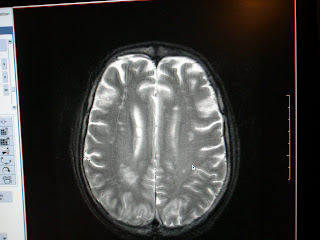

Large diffuse irregular hypertrophy of the soft tissues involving the distal leg, ankle and foot on the right side. No evidence of phleboliths or signs of arteriovenous fistulae or fat elements. The differential here for local gigantism would include Klippel Trenaunay Syndrome and Plexiform Neurofibromatosis.
Klippel-Trenaunay syndrome (KTS) is defined by the presence of a combined vascular malformation of the capillaries, veins, and lymphatics, congenital venous abnormalities, and limb hypertrophy. Most patients with KTS can be treated conservatively with compression stockings or pneumatic pumps. Compression stockings decrease edema, act as a barrier for minor trauma, and reduce venous insufficiency.
Surgical Care - Servelle reported successful surgical intervention (resection or ligation of abnormal blood vessels) in more than 700 patients with KTS. Most medical centers have tried to avoid surgical intervention. Surgical treatment can be complicated by infection, lymph seepage, and skin breakdown. Intravenous sclerotherapy has been proposed as an alternative to surgical intervention in KTS and to embolization in PWS. Reports exist of the use of a sclerosant in microfoam.
Clinicians at all centers agree that a leg length discrepancy of more than 2.0 cm warrants epiphysiodesis. Hypertrophied digits with severe deformity and infection may require amputation.
You can find more information on this topic here







